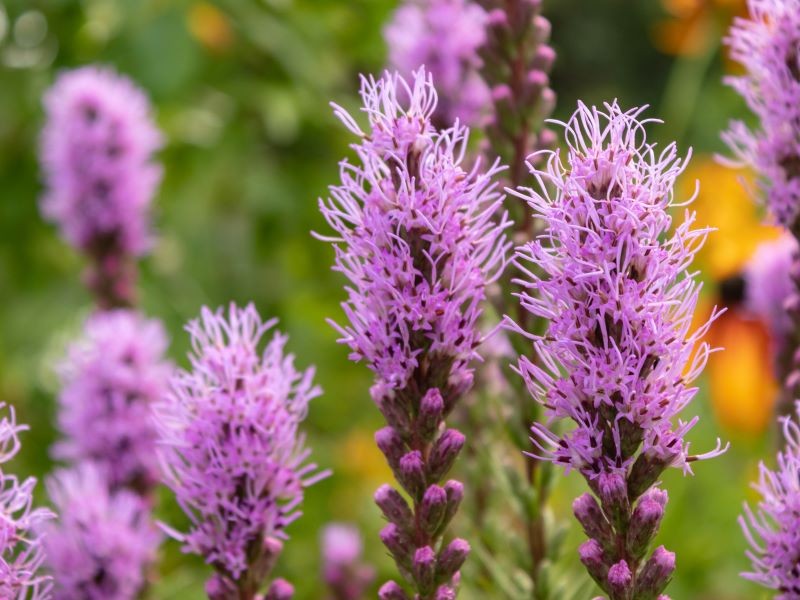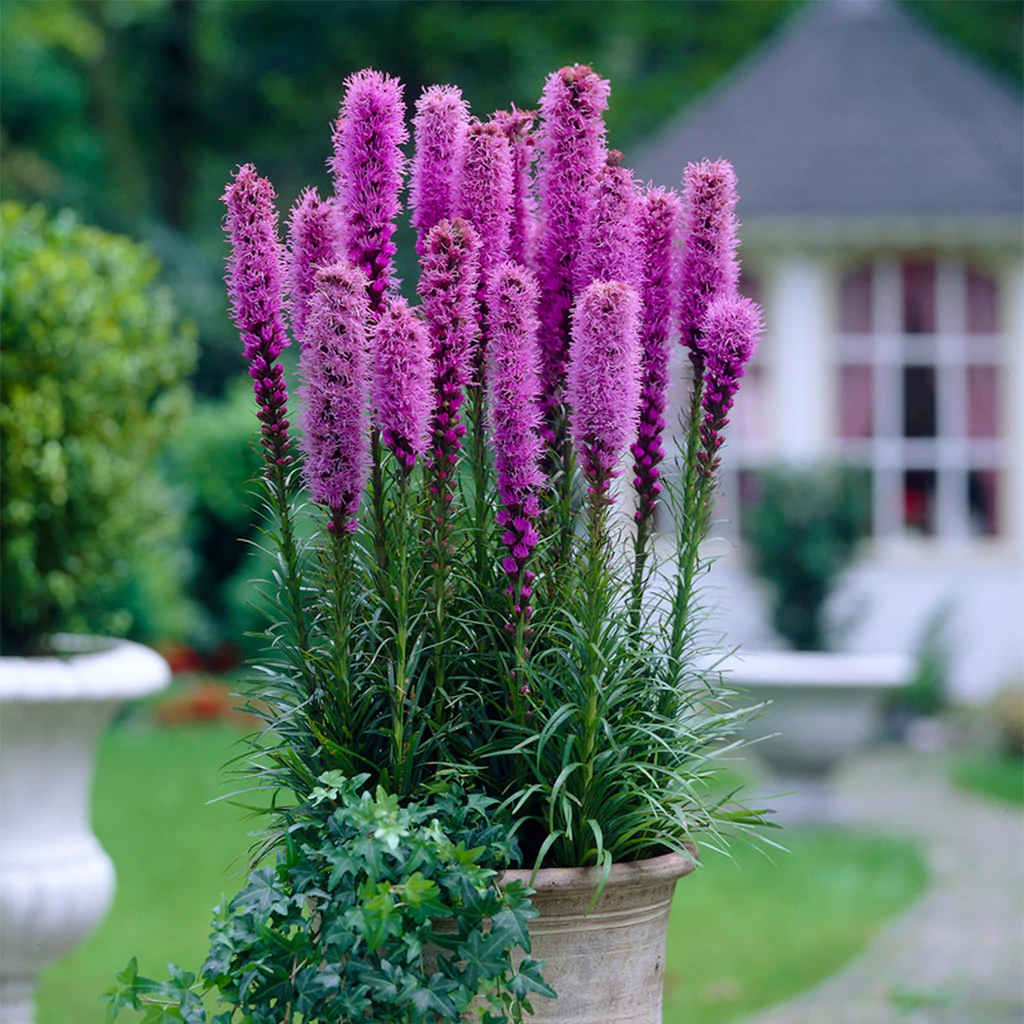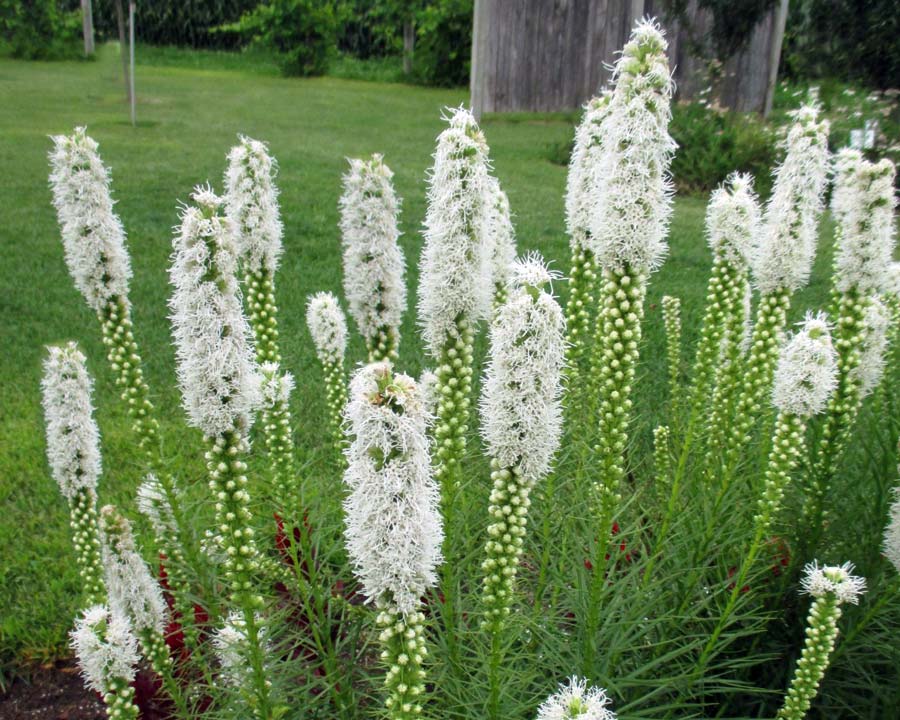Liatris Spicata - Imparare a Curare la Stella Fiammeggiante
La Liatris spicata è una pianta che cresce naturalmente nelle aree di prateria. Forma un caratteristico e denso ammasso di foglie al di sopra del terreno, dal quale si sviluppa una spiga verticale. È qui che compaiono i fiori della stella cadente. L'erbazzone è un elemento molto apprezzato in molte composizioni da giardino. Stupisce con un gran numero di fiori melliferi che attirano molti insetti benefici.

Stella cadente in giardino
La stella fitta, nota anche come piuma di fieno o Liatris spicata è una pianta perenne a bulbo della famiglia delle Asteraceae. Cresce naturalmente soprattutto in Nord America, di solito nelle praterie. Per il suo aspetto unico, sta diventando un elemento sempre più popolare dei cortili di casa.
La pianta è relativamente alta: cresce da 60 a 120 centimetri di altezza. Durante il primo stadio di crescita sviluppa foglie spesse che formano ciuffi particolari. Da questi emergono steli rigidi.
La pianta ha fiori distinti e fortemente sviluppati, che crescono fino a 30 centimetri di altezza Come caratteristica, i boccioli crescono dall’alto verso il basso. Gli appassionati di farfalle apprezzano molto questa pianta: i suoi fiori sono melliferi e attirano molte farfalle durante la stagione della fioritura.

Liatris spicata - le cultivar più popolari
Esistono molte cultivar di piante di stella cadente. Le due citate di seguito sono le più popolari.
- Kobold - questa varietà è nota anche come gayfeather viola o violetta. Il nome, ovviamente, deriva dal colore dei fiori. Raggiunge i 50 centimetri di altezza. È un’aggiunta perfetta alle aiuole e ai giardini rocciosi.
- La Alba è un’altra varietà popolare di questa pianta. Alcuni la chiamano stella bianca fiammeggiante. Cresce fino a 90 centimetri di altezza e i suoi fiori bianchi sono il suo principale vantaggio.
Stella cadente densa: ha bisogno di condizioni particolari?
La Liatris spicata è una pianta molto tollerante, che può crescere perfettamente sia in pieno sole che a mezz’ombra. Tenete presente, però, che potrebbe crescere male in piena ombra e sviluppare meno fiori.
L’importante è che il terreno sia permeabile e relativamente asciutto. La Gayfeather preferisce terreni leggermente acidi. Non cresce bene in zone paludose o umide: i bulbi marciscono semplicemente in queste condizioni.
A causa delle origini della pianta, le stelle cadenti dense possono sopportare bene i periodi di siccità. Tuttavia, se le temperature calde durano a lungo, assicuratevi di annaffiare la pianta per evitare che le foglie cadano.

Si può coltivare la Liatris spicata in vaso?
La Liatris spicata è una pianta perfetta da coltivare in contenitore. Si può creare un’interessante composizione con questa pianta, ad esempio come decorazione per il patio. Un luogo soleggiato crea le condizioni perfette per la crescita di questa pianta. Assicuratevi che il contenitore sia abbastanza grande, in modo che la pianta possa sviluppare liberamente il suo apparato radicale.
Quando piantare i bulbi di stella cadente?
Se volete che il vostro giardino abbia un aspetto eccellente in estate, la stella cadente densa è una scelta perfetta. Quando piantare i bulbi? Il periodo migliore per piantare la Liatris spicata è metà aprile. Quando decidete la posizione, ricordate che deve essere ottimale per la corretta crescita della pianta. Se piantate i bulbi di liatris spicata ad aprile, aspettatevi di vedere gli insoliti fiori della pianta a luglio.
Come annaffiare e concimare la Liatris spicata?
La Liatris spicata può sopportare temperature molto basse. I luoghi secchi non sono un problema per questa pianta. Tuttavia, è necessario annaffiarla durante i periodi di siccità, in modo che la pianta cresca in condizioni ottimali. In caso contrario, le foglie potrebbero seccarsi e cadere. Assicuratevi comunque di annaffiare la pianta con moderazione, perché il liatris non ama i terreni troppo umidi. Potrebbe far marcire il bulbo.
La concimazione è una questione altrettanto semplice, per quanto riguarda questa pianta. La stella cadente è autosufficiente, quindi non ha bisogno di un’alimentazione eccessiva. Tuttavia, è bene concimare la pianta almeno una volta all’anno. In questo modo la fioritura sarà più intensa.

Come propagare la Liatris spicata?
In pratica, significa che la pianta viene moltiplicata separando i suoi bulbi. Se volete propagare la pianta, scavate il bulbo e dividetelo in diversi pezzi più piccoli. Il processo non è complicato. In questo modo si possono ottenere molti nuovi bulbi, pronti per essere ripiantati.
Quali sono le malattie più comuni della Liatris spicata?
La Liatris spicata è vulnerabile soprattutto alle malattie fungine. Esse sono in genere il risultato di errori di coltivazione, come ad esempio l’aver piantato la liatris in zone troppo umide. Se la malattia viene colta nelle sue fasi iniziali, può essere ostacolata interrompendo le annaffiature o spostando la pianta in una posizione diversa.
Le stelle cadenti sono soggette a qualche parassita?
Le creature e i parassiti che vivono sottoterra sono la minaccia più grande per la Liatris spicata. I bulbi possono essere mangiati interi o rosicchiati, ad esempio, da talpe o arvicole, causando la morte della pianta.
Separare i parassiti dai bulbi è il modo più efficace per risolvere il problema. È possibile farlo, ad esempio, piantando i bulbi di gaia in vasi scavati nelle aiuole. Anche le reti speciali posizionate nel terreno sono metodi popolari.
La pianta può anche essere attaccata dagli afidi. In questo caso, è necessario spruzzare le piante colpite, ad esempio, con acqua saponata o infuso di cipolla. Se questi metodi non funzionano, utilizzate speciali pesticidi chimici.

📍 Quando potare il Liatris spicata?
La Liatris spicata deve essere potata dopo la fine della sua fioritura. La decapitazione dei fiori evita di spargere i semi in tutto il giardino. Il secondo taglio si esegue dopo il periodo di vegetazione: è il momento di potare l'intera sezione fuori terra della pianta.
📍 Quando piantare i bulbi di piume gay?
Pianificate la messa a dimora dei bulbi di liatris all'inizio della primavera. Metà aprile è il periodo migliore per la messa a dimora. Le stelle cadenti fioriscono in estate, a luglio e agosto, e continuano a produrre fiori fino a ottobre.
📍 Quando ripiantare le stelle cadenti?
Il reimpianto e la propagazione delle stelle cadenti devono essere pianificati con attenzione. Si può decidere di spostare la pianta in un altro luogo dopo aver notato che la sua crescita è ostacolata o che la fioritura è diventata più debole.
📍 Qual è il terreno migliore per la Liatris spicata?
Liatris spicata è una pianta molto tollerante nei confronti del terreno. Si consiglia un terreno ricco e permeabile. Un terreno secco e sabbioso con un po' di ghiaia è un'opzione perfetta.
Articoli in primo piano




